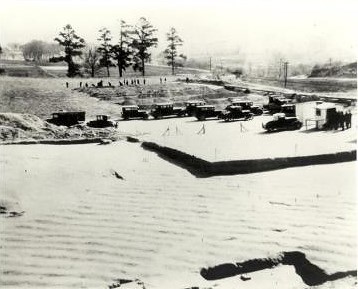Last updated: March 6, 2023
Article
Work Relief Archeology

NPS photo.
Aiming to combat the disastrous effects of the stock market crash of 1929 and the resulting Great Depression, President Franklin D. Roosevelt established work relief programs. Out of work Americans were employed to construct and maintain infrastructure across the country. Thanks to these programs, which began in 1933, not only were thousands of unemployed workers provided with jobs, but the practice and visibility of archeology grew rapidly in the decade that followed.
Among the most successful of the work relief programs were the Federal Emergency Relief Agency (FERA), the Civilian Conservation Corps (CCC), and the Works Progress Administration (WPA). Established in 1935, over the course of eight years the WPA employed over 8.5 million out of work Americans, and completed projects in nearly every county in the nation. The programs also supported numerous archeological projects.
The WPA and CCC employed both professional archeologists and untrained staff to conduct archeological examinations, curation, and perform historical research by surveying sites such as Irene Mound in Georgia, Catoctin Mountain Park, Dinosaur National Park, and Big Bend National Park.
Through these efforts, the American public became familiar with the practice of archeological excavation and its value as a science. In addition, work relief archeological projects trained a new generation of archeologists, creating a widespread interest in archeology, and providing employees with essential archeological training and diverse skills.
In fact, many NPS archeologists in the early and mid-twentieth century were involved in work relief archeology, including Louis Caywood, John Cotter, and Arthur R. Kelly (link). In addition to gaining valuable field experience, archeologists received more resources than ever before. Gordon R. Willey, a work relief archeologist at Macon, Georgia and Harvard University professor, recalled, “[T]hese operations were considerable. The relief rolls in Macon and surrounding territory were swollen in 1936, the depths of the depression and [project director Arthur] Kelly had several hundred men, armed with picks, shovels, and trowels, at his command.” The experience was just as impactful for crew members. The granddaughter of Hattie Coleman, who worked at the Irene Mound site where the excavation crew consisted almost entirely of African American women, believes Coleman, “...valued the Irene work as the most intellectual stimulation of her adult life.”
Visitors to national parks can today see the results of work relief archeology, at sites such as Jamestown, Ocmulgee National Monument, and Rocky Mountain National Park (https://www.nps.gov/parkhistory/online_books/rmnp/archeology.pdf). Relief workers dug miles of trenches, uncovered Native American sites, developed park infrastructure, and conducted stratigraphic surveys to understand the history of the land. At Ocmulgee alone, hundreds of relief workers were employed to excavate, catalogue, and record the many mounds and other Native American sites and artifacts. Among the finds was the first Clovis point discovered in Georgia.
A similar legacy of work relief archeology programs can be found in the NPS Southeast Archeological Center, which works with various parks across the southeastern United States to uncover, conserve, interpret, and preserve archeological materials. Born out of Depression-era work relief programs, SEAC preserves the legacy of New Deal archeology and serves as an important center of continuing archeological efforts in the United States.
Working in parks and historic sites across the country, relief workers and archeologists uncovered important information about America’s cultural and geological history that has contributed significantly to contemporary understanding of North American cultural heritage. Although work relief programs disbanded at the start of WWII, theirs remains one of the most important, formative chapters in the history of American archeology and the NPS.
Further Reading:
Shovel Ready: Archaeology and Roosevelt's New Deal for America, Edited by Bernard K. Means, University of Alabama Press (2013).
Emergency Archeology in the Missouri River Basin: The Role of the Missouri River Basin Project and the Midwest Archeological Center in the Interagency Salvation Program, 1946-1975, Thomas D. Thiessen (1999).
A New Deal for Southeastern Archaeology, Edwin A. Lyon (1996)
The Civilian Conservation Corps and the National Park Service 1933-1942: An Administrative History, John C. Paige (1985).
America’s National Park System: The Critical Documents, Ch.3 “The New Deal Years,” Edited by Lary M. Dilsaver (1994).
